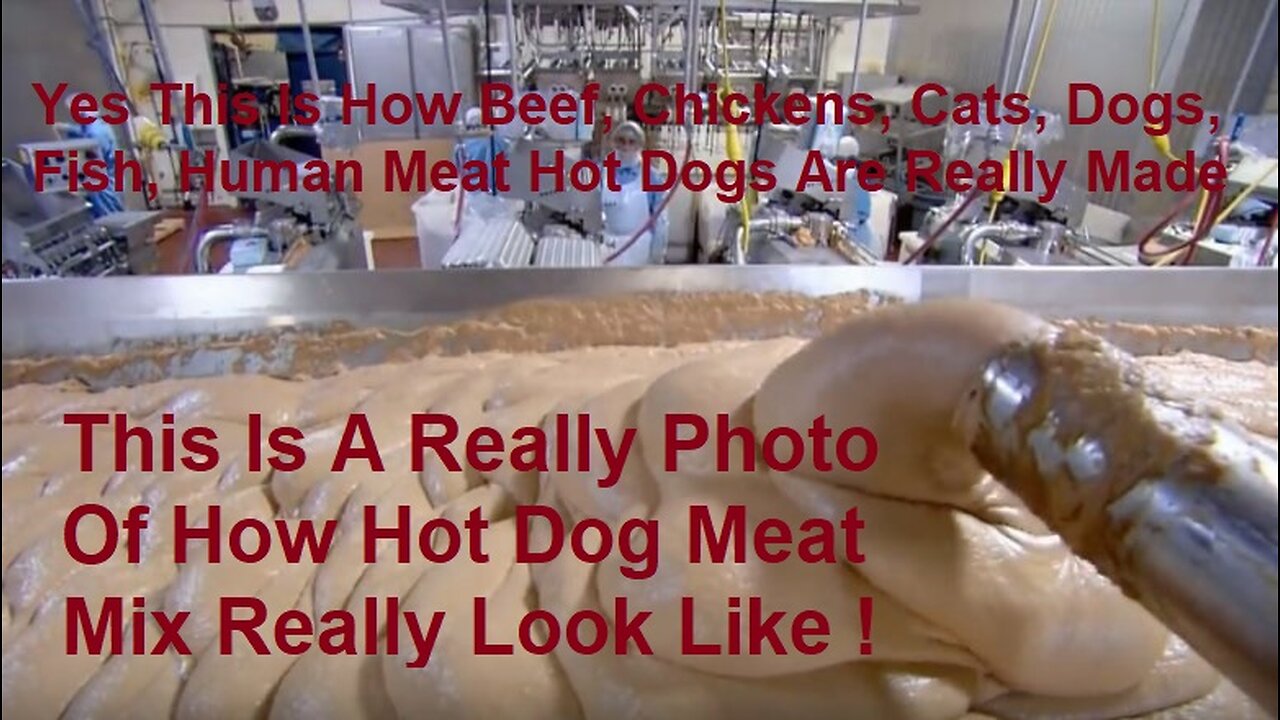Premium Only Content

This Is How Beef, Chickens, Cats, Dogs, Fish, Human Meat Hot Dogs Are Really Made
This Is How Really Meat Hot Dogs Are Made And How Lab-Grown Meat Is Made From Beef, Chickens, Cats, Dogs, Fish To Human Body Meat Hot Dogs Are Made And Has FDA's Approval For The First Time Although access to it has been limited throughout the years, lab-cultivated meat is not a new concept. You already know how the old saying goes: "If you love hot dogs, you'd better not look too closely at how they're made." The fact is, whether you love your hot dogs fried at home in butter, or steamed in a container of murky water from a pushcart in the big city, whether you take your dogs plain with just a dab of mustard, or piled high with tomato, pickles, neon-green relish, and celery salt, you probably haven't spent a lot of time squinting too closely at that tube of cylindrical cased meat.
Hot dogs have long been a favorite target among hardcore vegans and your woke friends with the more refined palates, who would never think of "poisoning their bodies" with such a heavily processed amalgamation of animal parts. The humble hot dog has taken a lot of heat for its perceived low-quality ingredients, seemingly questionable manufacturing and packaging processes, the lack of nutritional value, and the potential link between the consumption of processed meats and certain serious illnesses, including type 2 diabetes, cardiovascular disease, and some types of cancer.
But for all of the scary headlines, most of us don't fully understand how hot dogs are manufactured. We took a look at the entire process, from start to finish, and were surprised by what we found. Join us, as we take a detailed look at how hot dogs are really made.
Many of us take the existence of hot dogs for granted. After all, they've always been there for us, whether as a quick after-school snack or a late-night post-pub crawl bit of "get home" fuel. But where did hot dogs come from in the first place, and how did they become such a popular American dietary staple?
While humans have been making ground up animal meat into sausages for literally thousands of years, the product that we came to think of as the "hot dog" was developed much later. Some credit Frankfurt, Germany with the invention of hot dogs as early as 1484. Other leading hot dog scholars contend that the invention probably occurred in Vienna, Austria. Still others believe that the modern-day hot dog came even later, when Johann Georghehner (who was from Coburg, Germany) produced the "dachshund" sausage in the 1600s.
Whichever version of hot dog history you choose to believe, the product didn't arrive on American shores until the 1850s, when German immigrants Charles Feltman and Antoine Feuchtwanger began selling "dachshund sausages" topped with sauerkraut from a pushcart in Coney Island, New York. The product caught on at baseball parks, and Americans quickly developed a new national pastime: Eating hot dogs.
Ah, trimmings. It's a vague word designed to hide all manner of sins, isn't it? Early in human meat-eating evolutionary history, someone noticed that after carving all of the ribs, steaks, chops, hams, legs, and cheeks out of an animal, there was a pile of unappealing stuff leftover that really shouldn't go to waste. And it's this desire to use every part of the animal, which led to the invention of sausage, and eventually hot dogs.
Whether you choose beef, chicken, or pork hot dogs, chances are they're made up of a bunch of different animal parts that most wouldn't consider "prime cuts." The Food and Agriculture Organization of the United Nations (FAO) defines those as: "The raw meat materials used for precooked-cooked products are lower-grade muscle trimmings, fatty tissues, head meat, animal feet, animal skin, blood, liver and other edible slaughter by-products."
Sure, the term "slaughter by-products" may not exactly whet your appetite, but making hot dogs means making sure that no parts of the animals we raise and systematically kill go to waste, and that's a concept that most of us can get behind.
Before the real down-and-dirty business of hot dog manufacturing can begin, all of those unsavory trimmings have to be ground down into a more manageable, uniform product. Most often, the types of meat used in hot dogs are some combination of pork, beef, chicken, or turkey.
In the Unites States, hot dogs that contain sketchier cuts of meat must be labeled as containing "Byproducts" (organ meats) or "Variety Meats" (raw skeletal muscle). Those containing byproducts must be listed and called out by species on the ingredient panel. So-called "mechanically separated meat," whereby pork bone (but never cow bone; thanks, Mad Cow Disease) is pushed at high pressure through a sieve to scrape every last remaining scrap of usable meat off the carcass is permitted, but this kind of meat cannot make up more that 20 percent of the contents of the finished product.
The trimmings, along with assorted by products and variety meats, are loaded into giant meat grinders, similar to the ones you've seen the butcher using to grind hamburger at the grocery store. All of those different animal parts are finely ground at this stage, to form a sort of loose, pebbly-textured meat mashup.
After the all the components are ground together, with the resulting product looking more like usable meat and less like a disparate pile of scrapped animal garbage, it's time to start adding the flavor and texture ingredients that help differentiate one hot dog brand from the next.
Regulations dictate that finished hot dogs can contain up to 30 percent fat, and up to 10 percent added water. A full 3.5 percent of a hot dog can be made up of "non-meat binders and extenders," which can include dry milk or cereal. An additional 2 percent can be isolated soy protein, and all of these "extra" ingredients must be designated on the label.
The meat mixture might receive a heavy dose of salt (sodium phosphate, which keeps things moist), and additional preservatives and seasonings, which may include artificial and natural flavors, spices, corn syrup, or additional water. The exact recipes and proportions of ingredients vary from manufacturer to manufacturer, which is why all hot dogs tend to taste a little bit different from one another.
After the ground hot dog mixture has been appropriately seasoned and had all the preservatives and bacteria-inhibiting agents added, it's time for the really gross part. For many, this is the stage of the hot dog making process that is accompanied by visuals that will haunt your dreams.
The entire mixture is blended with water until it is smooth, resulting in a pale pink meat mixture that's roughly the color and consistency of bad buffet restaurant soft serve ice cream. And since nature abhors a too-dry wiener, additional water is added to get the consistency of the slurry just right.
The meat mixture is typically pureed again at this stage, and the excess air in the raw hot dog batter is vacuumed out of the meat in order to make the finished hot dog more dense and have a firmer texture. From there, it's on to the casing machines, to give the hot dogs their familiar shape that's perfect for buns.
While natural-cased hot dogs (which are typically made from the cleaned intestines of sheep or lamb) are growing in popularity, thanks in part to their characteristic snap, the biggest retail hot dog brands in the United States tend to be skinless. But whether they end up on supermarket shelves in a casing or not, casing the meat puree is still a big step in the manufacturing process; it's what gives hot dogs their signature shape.
After all of that pink meat batter passes inspection, it is pumped into an automatic stuffing and linking machine. The meat is blasted at high pressure into tube-shaped, cellulose casings (made from synthetic material), which are then twisted at precise intervals to produce a long string of equally-sized hot dogs. The production rate of these machines is incredibly fast; in fact, it takes just 35 seconds to produce a chain of hot dogs so long it would span the length of a soccer field... twice.
After being stuffed into their cellulose casings and twisted into precise lengths (usually about 5 inches), the hot dogs still need to be fully cooked before they can move to the next step in the manufacturing process.
At this point the hot dog strands are loaded onto giant conveyor racks and are first rolled through a shower of liquid smoke before moving into an oven with several cooking zones. Here, they are thoroughly cooked under controlled temperature and humidity conditions, and all that liquid smoke has a chance to permeate the casing for an added boost of flavor while they bake.
After the cooking process is complete, the fresh-from-the-oven hot dogs get one more shower, this time with cold saltwater, which helps to quickly drop their temperature and get them ready for packaging. But first we've got to deal with those inedible cellulose casings...
After cooking and cooling, the hot dog links are moved via conveyor to an automatic peeling machine, to strip them of their cellulose casings. Once they hit the peeler, the cellulose casings are sliced open with a tiny knife, and then the hot dogs are blasted with a burst of high-pressure steam, which blows off the casing and leaves just the bare naked hot dog remaining.
This all happens much more quickly than the time it took you to even read that sentence; a typical hot dog peeling machine can process upwards of 700 hot dogs per minute (or about 11-1/2 hot dogs per second), shooting them rapid-fire out the other side of the peeling machine like a firehose that dispenses a heavy stream of whole hot dogs instead of water, which by the way, would be singularly ineffective at keeping a house from burning down, but delicious nonetheless.
After being smoked, receiving their cooling spray of life-giving saltwater, and being stripped of their casing, the nearly-finished hot dogs move along a conveyor belt where they receive a final inspection. The hot dogs get a quality control check to ensure they're the proper weight, and only tubed meat that could be considered flawless (which is a term that we use somewhat loosely, now that we know what's inside of them) makes it through these final quality control checks, before being passed off for packaging.
Hot dogs which are damaged, broken, or torn at any point in the process are pulled from the line and prevented from entering the packaging process, ensuring that every package of hot dogs you crack open for a backyard barbecue is consistent, perfect, and ready to hit the grill. Because honestly? If you ever opened a package of hot dogs to find a mutilated, shredded mess, you would never buy that brand again.
Ah, the final step, when hot dogs can begin the last part of their journey from "pile of meat scraps" to finished product, nestled all cozy and delicious in a steamed bun at your backyard barbecue. After the cellulose casings are removed and the finished hot dogs receive a final quality control check, the hot dogs make their way to the packaging machinery. Here, hot dogs are lined up on sheets of plastic film printed with all of the graphics and marketing claptrap commonly found on supermarket dogs. The film is folded over and vacuum-sealed to preserve the hot dogs' flavor and extend their shelf life, and then transported to a stamping machine, which prints a freshness date on each individual package.
After packaging, the finished hot dogs are shuffled off into boxing machines, loaded onto pallets, and shipped in refrigerated trucks to supermarkets, to be loaded into shopping carts and shoved down the gullets of families nationwide. The entire process may seem like a long, complicated journey, but it all happens remarkably quickly; it takes just a few hours to manufacture each batch of hot dogs, from the time the meat first rolls into the factory, to the time the delicious finished product is boxed up and shipped out.
Hot dogs are just about as American as baseball games and apple pie. Whether you prefer yours simple with a squeeze of mustard, or you'd rather load it up with chili, cheese, and onions, chances are you'll partake in at a few of them this year. At least that's the assumption, given the statistics shared by the National Hot Dog and Sausage Council (yes, that's a real thing). Their website states that in 2018 Americans spent more than $3 billion on hot dogs, and are expected to consume more than 7 billion of the popular wieners between the months of May and September — you know, "peak hot dog season."
But just because hot dogs are so popular (they're practically a staple at barbecues and baseball games), that doesn't mean they're the best thing you can put in your body. These cylinders of encased meat have a few dirty secrets lurking inside — especially if you're buying the cheapest versions on the market. Here are the things you don't really want to know about hot dogs, but that may help you make better buying decisions when you do throw a package in your shopping basket.
Look, everyone's heard the horror stories about finding foreign objects in food. Fast food joints tend to be big culprits, but the reality is, sometimes things go wrong in food processing, and items you don't really want to eat end up in your favorite fare. Unfortunately, hot dog manufacturers can't claim a completely clean record on this front. According to a 2015 article published in TIME magazine, 38 people had reported to the USDA's Food Safety and Inspection Service that they had found foreign objects in their hot dogs. Of course, 38 people is a small number given how many hot dogs are consumed each year, but remember, those are just the ones who took the time to make a report.
So what types of items have people found in their franks? The TIME magazine article reports the following (just to name a few):
"A piece of rubber band"
Tiny, hard white pieces of plastic
"A clump of hair or something ratlike"
"The tip of a razorblade"
"Glass shards"
Various pieces of metal (a wire, a staple, a button)
"A piece of bone"
"What looks like insect larva"
While the list is enough to make a person swear off hot dogs for life, the article also points out that hot dog recalls are relatively rare, so you can (mostly) trust that the hot dogs you buy won't come with an extra side of metal or plastic.
When you're starving and don't have a minute to spare, it's easy to think you can hit up the fridge, grab a hot dog, and eat it cold, right? Like other sandwich meats, hot dogs are already cooked, so it shouldn't cause a problem. And yet, according to John Muir Health, hot dogs (along with items like potato salad, chicken, and egg dishes) are "frequent offenders" for food poisoning. And if you've ever had food poisoning, you know you want to avoid another bout of this stomach issue at all costs.
According to an article published by the U.S. Food and Drug Administration (FDA), the issue comes down to hot dogs getting contaminated with Listeria monocytogenes after being processed and packaged. The FDA's clear advice — always reheat hot dogs until they're "steaming hot," and if you can't reheat a hot dog before eating it, you need to find something else to eat. It's just not a good idea to eat a cold, straight-from-the-package wiener.
So you probably understand that your hot dog (usually) comes stuffed inside a casing. This casing gives the hot dog its shape and also helps keep all the juices inside. If you've ever pricked a hot dog with a fork before putting it in a pot of boiling water or in the microwave, what you're doing is opening up the casing just a smidge to allow steam to exit the casing while the hot dog cooks. What you might not realize, though, is that whenever a label says "natural casing" or the ingredients include an item like "encased in sheep casing" or "encased in lamb casing," what that really means is that the hot dog is encased in animal intestines. Yum, right?
Here's the thing, though — it sounds gross, but it's not unsanitary or unhealthy (at least, not any more so than eating that hot dog in the first place). A writer for HuffPost conducted an interview with Boyd Adelman, the president of Sabrett, a hot dog manufacturer, in 2017. In this interview, Adelman explained that the intestines are completely cleaned before being used, so there's no risk of fecal contamination. And when you choose hot dogs with natural casings, you're helping reduce food waste and promote consuming the whole animal when animals are butchered for food. That said, if you can't stomach eating animal intestines, look for skinless hot dogs — these are prepared with cellulose casings that are removed before packaging.
When you think hot dog, you think "meat," right? What else could a hot dog possibly be? And if you take the time to read ingredient labels, meat is typically listed as the first ingredient, followed by water, on hot dog labels. But that's not exactly true. According to a study titled "Applying Morphologic Techniques to Evaluate Hotdogs: What Is in the Hotdogs We Eat?" published in 2008 in the Annals of Diagnostic Pathology, scientists analyzed eight different brands of hot dogs to determine what, exactly, each hot dog consisted of. While "meat" (i.e., skeletal muscle — don't freak out, whenever you eat meat, you're pretty much always eating a combination of skeletal muscle and fat — that's literally what meat is) was listed as the first ingredient across the board, the actual skeletal muscle in each brand ranged from just 2.9 percent to 21.2 percent by volume, while water accounted for 44 percent to 69 percent of the weight of each hot dog.
So yeah, your hot dog is mostly water. And a little bit of meat. And what else, you might ask? Well, if you really want to know, it's a "variety of tissues," including bone, collagen, blood vessels, plant material, peripheral nerve, adipose tissue (fat), cartilage, and skin. Yikes. But if it helps at all, the study also noted that "brain tissue was not present." Thank goodness for small blessings?
Okay, so beyond knowing the specific type of animal tissue you're consuming when you eat a hot dog, you might want to know what part of the body these tissues are being derived from, right? Well, hopefully, you understand that hot dogs aren't encasing prime cuts of beef or pork inside those cellulose or animal casings. It's not like you're paying an exorbitant amount for your package of dogs, even when you buy the high-end variety, so you have to know you're eating meat that's considered lower-grade.
According to a 2017 article published in Business Insider, hot dogs start with meat "trimmings." This vague descriptor basically means that the meat is taken from the "leftovers" of an animal after all the other, better cuts of meat are cut away. The article goes on to specify that these "trimmings" may come from lower-grade muscle, fatty tissues, head meat, animal feet, animal skin, blood, liver, and other "edible slaughter by-products." And that "head meat"? It's literally what it sounds like. Meat removed from the bones of an animal's head, which may include the cheeks.
Unless the hot dog ingredients include the label "byproducts" or "variety meats," it won't contain meat from the snout or lips. It also won't include eyes or brains... so that makes it better? Just remember, you typically get what you pay for — buying kosher dogs or 100-percent beef, chicken, or pork hot dogs is likely to be a better option if you're trying to steer clear of the less desirable "trimmings."
You probably haven't heard dietitians touting the health benefits of hot dogs as a way to reduce your risk of obesity, heart disease, or diabetes. That's because, obviously, hot dogs aren't a beacon of health. According to the Oscar Mayer website, the classic beef wiener contains 12 grams of fat (5 grams saturated), and 360 milligrams sodium. And that's just the hot dog. How often do you eat a single hot dog plain, without a bun or extra toppings? Probably rarely, if ever. If you're chowing down on two or three dogs in a sitting, along with a bun and an assortment of condiments, a single meal could rack up your fat and sodium intake pretty quick. Once in a blue moon, a meal like that won't do much damage, but if hot dogs are a staple in your weekly diet, it might be time to reassess.
Do keep in mind, though, that there are lots of different varieties of hot dogs on the market, including chicken dogs, turkey dogs, and lower-fat beef or pork dogs. You can even find tofu- or soy-based vegetarian versions. Each product will have its own nutritional information, and some might have lower levels of fat and sodium.
Maybe you've seen the videos. Maybe you've heard about them. Maybe you've been putting your head in the sand to ignore the rumors about how hot dogs are made so you can enjoy your frankfurter in blissful ignorance. Well, if you're ready to take off your blinders, here's the deal: Hot dog making is pretty gross. There's a five-minute How It's Made YouTube video you can watch if you're so inclined. Word to the wise: Don't watch it while eating... especially if you're eating hot dogs.
Depending on whether your hot dog contains "meat" or "mechanically separated meat," as defined by the USDA, in the list of ingredients, you may or may not be getting "extra calcium" (i.e. bone shavings) in your hot dog. If your favorite hot dog uses the word "meat" in its ingredients, it was likely separated from the animal using "meat recovery systems" or "advanced meat bone separation." This is similar in appearance to "hand separated meat." If your favorite hot dog uses the word "mechanically separated meat," you're consuming "batter-like or paste-like meat product produced by forcing bones, with attached edible meat, under high pressure through a sieve or similar device to separate the bone from the edible meat tissue." Sounds lovely, right?
So what exactly does the "mechanically separated meat" (MSM) used in many (but not all) hot dogs look like? The USDA might call it "batter-like or paste-like meat product" – neither of which sounds all that appetizing — but it still sounds better than "white slime," right? Well, when you buy hot dogs that include the phrases "mechanically separated meat" or "mechanically separated poultry" (MSP) in the ingredient list, you're consuming white slime.
White slime is what results when the bones of what's left of an animal and the remainder of the bones' attached tissue get forced under high pressure through a sieve, pumping out the edible portions while leaving the bones behind. The edible portions come out in a paste-like substance that amounts to meat sludge. It's this sludge, slime, paste, or batter (you choose your preferred descriptor) that then gets pumped into casings before being cooked and packaged into your favorite cookout treat.
If you can't handle this reality, read your ingredient labels. Higher-end hot dogs that include "meat" on the label (doesn't matter what kind of meat — beef, pork, chicken, or turkey), rather than MSM or MSP don't utilize white slime.
Think for a second about what happens when you cook beef, pork, turkey, or chicken without any seasonings — you end up with a gray or white-ish meat, right? And considering hot dogs are pre-cooked using one or two of these various meats before being packaged, it just makes sense that hot dogs should look gray or white-ish. And yet, most hot dogs on the shelves of your local grocery store have a nice pink hue. So what gives?
A 2018 article published in Inverse points to sodium nitrite or sodium nitrate. These compounds are used in processed meats to help preserve meat and add flavor, but they also help give these meats their appetizing pink or red color. A fresh cut piece of steak is nice and red, right? But as it gets older it loses its red color. This has to do with the myoglobin in meat turning red when bound to oxygen. Over time, oxygen "falls away" and the meat loses its red tint. Sodium nitrite, on the other hand, can bind to myoglobin in place of oxygen and create this same "heme" that has a red hue. But unlike oxygen, it doesn't "fall away" as quickly, providing meat with a red tint for much longer.
The problem? As the article in Inverse points out, nitrites and nitrates have been linked to incidences of cancer. If you're concerned, look for hot dogs made without preservatives.
Most people would do well to eat fewer hot dogs overall. And by "fewer," let's say most people should limit consumption to a few hot dogs a month. As in, two or three. Total. But that's most people, not people involved in the weird, weird world of competitive eating.
In the world of competitive eating, particularly for the world-famous Nathan's Hot Dog Eating Contest which is held annually on the Fourth of July, competitive eaters have 10 minutes to stuff their faces with as many hot dogs and buns as they can. Sporting News reported that in 2018, a new world record was set by Joey Chestnut when he demolished 74 hot dogs. Think about that for a second — 74 hot dogs. If contestants are consuming Nathan's Skinless Beef Franks, Chestnut consumed 9,620 calories, 888 grams of fat (370 saturated), and 35,520 milligrams sodium in 10 minutes. That's downright obscene.
According to another article in Sporting News, in 2019, winners of the contest (Chestnut won in 2017 and 2019, too) earned a $10,000 purse — and if someone can consume 74 hot dogs in 10 minutes, the purse was well-earned.
Kids love hot dogs. And parents love feeding kids hot dogs because: 1) they're inexpensive, 2) like chicken nuggets, they're practically guaranteed to be eaten without protest, 3) they're quick and easy to make, and 4) kids can choose their own toppings and customize to their heart's content. Unfortunately, the long, lean tube-shape of the humble hot dog is practically identical in shape and size to a human esophagus.
According to John Hopkins Medicine, choking on hot dogs is the leading cause of food-related choking in kids under 3 years old. So while your little one might want to eat a hot dog the way you do — encased in a bun straight off the grill — it's best to slice or mince their dogs into much, much smaller, less tube-like pieces. And it's not just the littlest kids that you need to think about — according to an article in The Washington Post, choking on food is the 19th leading cause of death in the United States, with about 17-percent of food-related choking deaths attributed to hot dogs. So, yeah, maybe everyone should start enjoying their hot dogs like Shake Shack's "flat top style," which are sliced in half before being grilled. Anything to help save a life, right?
There's something quintessentially American about hot dogs. At best, they're a staple of long, lazy summer days and at worst, they're suspicious tubes of mystery meat in a casing you probably don't want to ask too many questions about.
The nature of hot dogs means there are a lot of stories about what, exactly, is in them. It's nothing new, and it's not going to stop any time soon, either. Snopes says in 2017, a fake news story from World News Daily Report started making rounds on the internet, claiming a hot dog vendor in New York City had been caught using meat from real dogs for the dogs he was selling on the street. It was a completely false news story, but the idea that there's good hot dogs and very, very bad hot dogs is still pretty accurate.
Mystery meat aside, there are definitely some hot dogs that'll be a hit when they come off any grill, and some you should probably avoid. Let's talk hot dogs, and the ones you should — and shouldn't — pick up this summer.
If you're looking for a delicious dog with a more than a little history and some serious Americana cred, look no further than Nathan's Famous. Nathan was a very real person named Nathan Handwerker, and his hot dogs shot to fame after he staged a Fourth of July hot-dog eating contest in 1916. The event became an annual one, and the Smithsonian says the popularity of the Polish immigrant's five cent frankfurters skyrocketed from there.
Even at the turn of the century, people were pretty suspicious of hot dogs. Handwerker even hired men and dressed them as doctors to convince the public his dogs were healthy, and it worked.
And they're still the same dogs you get today. Thrillist says the recipe isn't just called "original," it really is. It hasn't changed since 1916 since Nathan himself developed the recipe, so if you want some great dogs with a ton of history and some classic Americana, you can't go wrong with Nathan's.
Gluten-free hot dogs might seem like a bit of an odd thing to talk about, but for those diagnosed with celiac disease, it's a huge deal. When VeryWell Fit put gluten-free hot dogs under the spotlight, they found that they're not all created equal.
According to the FDA, hot dogs can be labeled gluten-free if their gluten content is less than 20 parts per million. There are a number of brands that meet the criteria, and more who don't. Many — like popular Hebrew National — can be considered to contain no gluten, but at the same time, they're not gluten-free. That happens when they're prepared in a facility where gluten cross-contamination is a possibility, and that brings us to Sabrett. They're one of the few hot dog manufacturers that have a gluten-free certification from the Gluten-Free Certification Organization, and they go beyond what the FDA requires. Their gluten content is less than 10 parts per million, so if you're looking for something you can serve safely, Sabrett is it.
By now, everyone has heard about the World Health Organization's declaration that processed meats were classified as a group one carcinogen. Part of the problem with these types of meats is the nitrate and nitrite content. According to The Guardian, the official ruling is that problem meats are generally those that have been salted and cured — like most hot dogs — and that's where Applegate Farms hot dogs come in.
Fox News named them as the best all-beef hot dogs you can buy, for a few reasons. They're uncured, which means they don't have any added nitrates or nitrites, which are usually added to cured meats to help with the preservation process. They're also fairly low in sodium (for hot dogs), with only 330 mg per dog. Calorie-counters won't be too offended either, as they clock in at just 110 calories per dog.
They also go above and beyond industry standards when it comes to animal welfare, using only animals raised with no antibiotics, no crates, plenty of space, and no painful alterations to teeth, tails, toes, and beaks.
When Berkeley Wellness took a shot at finding a healthier hot dog, they found it was challenging at best. Hot dogs definitely aren't a health food, but you should be able to eat a couple without ruining your day or your diet, right?
One of the healthiest options they found was Boar's Head Lite Beef Frankfurters, a 90-calorie dog that only contains 6 grams of fat and 270 mg of sodium. That might not sound horribly healthy, but many of the popular brands of hot dogs will provide you with a few days' worth of calories and sodium in a single meal.
There's another bonus to these, too. If the idea of that mechanically-separated meat makes you squirm a bit, Insider reports Boar's Head only uses whole-muscle meats. That should make almost anyone feel better about serving up a platter of hot dogs.
There's another super-healthy option buried among the many, many different kinds of hot dogs, and it's made by Trader Joe's. Their All Natural Uncured Chicken Hot Dogs were named the best chicken dog by Health, and it's no wonder: They only contain 60 calories, 250 mg of sodium, and 2.5 grams of fat. They also come with a decent amount of protein — 9 grams — and no mystery meat, just chicken. (And no, not all chicken dogs are created equal: Rocky's has five times the fat and twice the sodium!)
If you're looking for another reason to try chicken hot dogs, the Environmental Working Group has it. They looked at the total greenhouse gas emissions for all different kinds of food, and found that while lamb, beef, and pork were pretty high on the charts, chicken ended up being the most efficient meat and the best for the planet. Go green, grab some chicken dogs!
It's all right if you grew up on Ball Park franks, they're a popular brand. But you're an adult now and you know better, so let's look at just how bad these are for you. Berkeley Wellness listed them as one of the hot dogs you should absolutely pass on, because not only are they 190 calories and 16 grams of fat each, but each one contains between a quarter and a third of your entire daily recommendation for sodium. The American Heart Association recommends you try to limit yourself to around 1,500 mg a day, and that's made even harder when you consider each Ball Park frank has around 550 mg — before toppings.
That's just for the standard, regular-size dogs, so you can just imagine what you're getting in the jumbo dogs. Curious? A single Grillmaster dog clocks in at 260 calories, 24 grams of fat, and 780 mg of sodium. Even their Lean dogs aren't incredibly friendly when it comes to sodium — they contain 480 mg — so maybe just skip the old favorites and try something new.
These make the "bad" list not just because they're bad for you, but because they're masquerading as being good. You'll probably glance at them, think the lower-fat turkey hot dogs are a good idea, and that's all the farther you'll go. But they're fairly high-calorie (having 100 calories each), and they're high in fat and sodium, too. With 8 grams of fat and 510 mg of sodium (via CBS News), these definitely aren't a healthy grill option.
Oscar Mayer's Light Wieners (made with turkey and pork) get an honorable mention here, too. Even though they boast they contain less fat and calories than their heftier cousins, they're still going to set your diet back in a pretty impressive way with 6 grams of fat each. And in case that tempts you to have an extra one, you should also know each one has 380 mg of sodium (via CBS News). That adds up very, very fast.
This one's a little different, because it's a problem that's so widespread across all different brands of veggie dogs that it's worth talking about. People have different reasons for becoming vegetarian, and if you think a vegetarian hot dog is a good idea for any of your meat-free friends and family, there's a good chance you're mistaken.
In 2015, Clear Food did a deep-dive into just what's in a hot dog, and looked at the genome sequences from 75 different brands of hot dogs. They found (via USA Today) that 14 percent of them didn't contain what the package claimed — and that included veggie dogs.
Ten percent of hot dogs labeled as vegetarian contained meat products of some sort, and that means there's pretty good odds you're getting meat in your veggie dog. The report didn't name the brands, and instead, they suggested it's a widespread problem across the industry. (In all fairness, Hebrew National, Butterball, Eckrich, and McCormick brands were found to be among the most honest when it came to matching contents and packaging.)
Clear Food's 2015 hot dog testing found another disturbing trend, one that seems to suggest that sometimes, food myths are there for a reason. Hot dogs have always had a reputation as being mystery meat, and they found that a lot of the time, we absolutely don't know what's in them.
There are a huge number of people who avoid pork products, and you'd hope labels like "Kosher" and "Halal" reflect what's in the dog. Clear Food found (via Apollo Hospitals) that's not always true, and that three percent of their sample group was made up of hot dogs that swapped in pork as a substitution for chicken or turkey. Worse, some of them were still labeled as Kosher and Halal.
If you're avoiding pork for any reason, you might want to think twice about pork-free hot dogs. They might not contain what you think they contain.
Who doesn't love a corn dog? They come with an extra dose of nostalgia and that's great, but Morning Star's vegetarian corn dogs come with a whole bunch of other stuff, too.
First, let's point out that since they're vegetarian, it's our default setting to believe they're going to be better for us than a meat-filled dog. That's not entirely true, especially when it's a corn dog! These clock in at 150 calories each (which isn't terrible, for a corn dog), but they also have a pretty shocking 470 mg of sodium. To recap, that's around a third of what you should be eating for the entire day, all on a single stick (via CBS News).
There's another problem here, too. Not only are they full of fillers, extenders, and ingredients designed to mimic the texture of meat, they're so heavily processed those vegetarian ingredients aren't even recognizable anymore.
Having confidence in the authenticity of your food ingredients is essential to protect your brand against food fraud: a topic of increasing concern in the food industry and an area highly regulated by authorities through food labelling regulations. Food fraud costs the food industry around $15 billion globally1, 2 however the complexity of the food supply chain is challenging the abilities of analytical tools used for traceability of ingredients. The Thermo Scientific™ Next Generation Sequencing (NGS) Food Authenticity Workflow brings the power of NGS technology to your lab making it possible to identify the plant, fish and meat species contained in the most complex food samples. Let us help you to protect your customers and your reputation against intentional, or accidental, adulteration.
Lab-Grown And Real Human Meat Was FDA Approved Cannibalism A Sprit Cooking
There is something deeply disquieting about cannibalism. Motives and technicalities do not matter; eating human flesh is now universally considered revolting, whatever the circumstances. However, if we trust a long line of anthropologists and ethnographers, this has not always been the case in all parts of the world and is therefore not self-evident.
How Americans And World Are Tricked Into Buying Fake Food Learn the Difference ?
The food in your kitchen cabinets may not be what it seems. Fraudsters motivated by economic gain secretly infiltrate the global food market through a variety of means, including counterfeits, dilutions, substitution and mislabeling, according to the Global Food Safety Initiative. This may not only harm consumers’ wallets, but it can also put public health and safety at risk. Some estimates say food fraud affects at least 1% of the global food industry at a cost as high as $40 billion a year, according to the FDA.
600 Billion Dollars Poison Ingredient Making Your Food Toxic To Eat Processed Food
Nina deserves a lot more accreditation on this video, she was one of the first people to shed light on the problems with seed oils and the history of how they came to be. Top Ten Toxic Food Ingredients in Processed Food - Any food that has been canned, dehydrated, or had chemicals added to it is a processed food, and these foods make up about 60 percent of the average American diet. - Most of us don't think of the food we eat as poison, but some of the ingredients commonly found in processed foods can be considered toxic. By "toxic," I mean chemicals or highly processed ingredients that aren't good for you or can cause harm to your health. I'm talking about refined grains, trans fats, high fructose corn syrup, and all the other artificial junk you can't even pronounce on the ingredient lists.
What is left out of our food labels? Behind the cow industry are disturbing secrets you are not supposed to know. Supermarket beef has become an industrialized, unnatural product laced with lies beyond the labels. What actually happens to that meat before it reaches grocery store shelves? In this blog I’ll unveil the dirty truth behind the cattle slaughter process everyone needs to hear.
Human Meat Project - New Shake 'N Bake Fetus - Campbell Cream of Fetus Soup?
Welcome to the Human Meat Project, we are the human meat donation program. By donating bodies for human consumption, we are taking action to solve overpopulation, which leads to climate change and the greenhouse effect caused by the mass farming of livestock animals in order to feed the world. How About A New Shake 'N Bake Kitty Flavors - Like Aborted Fetus ? or Campbell Cream of Fetus Soup If you have a craving for Aborted Fetus Soup, then we’ve got some bad news for you. An Oklahoma Senator, Ralph Shortey, has now outlawed “the manufacture or sale of food or products which use aborted human fetuses.”
Planned Parenthood Kills Them and Then Sells Their Organs. Which is Worse? Planned Parenthood Is Largest Food Suppliers Human Meat In The World Today. "You Are What You Eat." Most of us have likely heard this saying before and are familiar with its simple and sensible meaning. When we were younger, this adage taught us (hopefully) to take care of what we put into our bodies because the food we eat can have a direct affect on our health as a whole. Selling Human Meat Per Planned Parenthood Rules All Sell At Cost/Lost For Non-Profit Organization.
Federal law prohibits the commercial sell of human meat and trafficking of fetal tissue for profit and carries a penalty of up to 10 years in prison and a $500,000 fine.
(Key Word Is (( 4 Profit )) Per Federal Law and Pedophile's Eating Alive And Aborted Baby and Kids... Is O.K. If Only Sell Human Meat Is At Cost or At A Lost.
P.S. Planned Parenthood Only Sell Human Meat At Cost/Lost... After Paying All Employee Hourly Wages and Other Cost To Run A Not-For-Profit Organization.
Not only must the organization meet the requirements that the state where it is organized sets for non-profits, but it must also meet complex IRS regulations. These regulations are used not only to determine if the organization is exempt from tax under the organization's activities as a non-profit organization.
What Is Lab Grown Meat ? How Is It Made From Beef To Human Meat Cell Guide Etc.
How Lab-Grown Meat Is Made From Beef, Chickens, Cats, Dogs, Fish To Human Body Meat And Has FDA's Approval For The First Time human body meat. The Food and Drug Administration (FDA) announced it has cleared all lab-grown meat product as safe for human consumption for the first time.
In a news release, the agency said that after reviewing information from 100s foods company is making from cultured chicken, cats, dogs. cows and baby cells, it has “no further questions at this time about the 100s firm’s safety conclusion.”
The agency noted that before can bring its products to the market, the facility in which the food is made will have to meet inspection standards from the FDA, the U.S. Department of Agriculture (USDA) and the USDA-Food Safety and Inspection Service (FSIS).
“The world is experiencing a food revolution and the U.S. Food and Drug Administration is committed to supporting innovation in the lab-grown from cows, cats, dogs, baby in are food supply. As an example of that commitment, today we are announcing that we have completed our first pre-market consultation of a human food made from cultured lab-grown from cows, cats, dogs, human baby and other animal cells.”
Eating cats and dog and fish Alive Educational Film ** GRAPHIC ** Green Eggs and Ham -
Asia is the continent on which the consumption of dog meat is most widespread, with as many as 30 million dogs killed for human consumption each year according to estimates by the Humane Society International. This estimate includes many family pets, which are often illegally stolen from their homes and taken to be slaughtered. The consumption of dog meat is said to be most common in China, South Korea, the Philippines, Thailand, Laos, Vietnam, Cambodia, and the Nagaland region in India, but it is not considered widespread in any of these locations. Moreover, the practice is becoming less popular in many countries, where younger generations are more likely to regard dogs and cats as companions rather than cuisine.
Truth Behind Meat Production Chicken Waffle Beef Burger An Eye-Opening Exploration -
Narrated by Oscar-nominee James Cromwell, this powerful film takes viewers on an eye-opening exploration behind the closed doors of the nation's largest industrial farms, hatcheries, and slaughter plants -- revealing the often-unseen journey that animals make from Farm to Fridge. If this documentary moves you, please take a moment to consider if these animals lives are worth taking for merely taste. Thinking about going vegan? The Truth About the Meat Industry
What is left out of our food labels? Behind the cow industry are disturbing secrets you are not supposed to know. Supermarket beef has become an industrialized, unnatural product laced with lies beyond the labels. What actually happens to that meat before it reaches grocery store shelves? In this blog I’ll unveil the dirty truth behind the cattle slaughter process everyone needs to hear.
Pedophile's Eating Alive And Aborted Baby And Young Kids Too Rejuvenating Potion
Planned Parenthood Kills Them and Then Sells Their Organs. Which is Worse? Planned Parenthood Is Largest Food Suppliers Human Meat In The World Today. "You Are What You Eat." Most of us have likely heard this saying before and are familiar with its simple and sensible meaning. When we were younger, this adage taught us (hopefully) to take care of what we put into our bodies because the food we eat can have a direct affect on our health as a whole. Selling Human Meat Per Planned Parenthood Rules All Sell At Cost/Lost For Non-Profit Organization.
https://www.govinfo.gov/content/pkg/CHRG-114hhrg96052/html/CHRG-114hhrg96052.htm
The Center for Medical Progress, whose undercover videos exposed Planned Parenthood leadership negotiating the harvesting and sale of aborted fetal body parts, released a new video today featuring Planned Parenthood officials’ sworn videotaped testimony about the sales.
On November 16, 2022, the FDA approved UPSIDE Foods' request to grow meat from cells. According to the FDA, it stated that workers "have no further questions at this time about the firm's safety conclusion." In the past, people have been concerned about the labeling of cultivated meat, due to the nuances that would cause in the meatpacking and livestock industries, but the FDA clearly states that the company's goals are "to take living cells from chickens and grow the cells in a controlled environment to make the cultured animal cell food."
UPSIDE Foods is the first cultivated meat company in the world and was founded in 2015, according to its website. It has the goal of "cultivating new foods to serve audiences around the world."
However, according to Wired, the company's production facilities still need inspection by the United States Department of Agriculture (USDA) before it sells its food products, which then have to be checked for quality.
Ouroboros Steak, a meat cultivated from human cells and expired blood, has been developed by a group of American scientists as a thought-provoking art piece to challenge the sustainability practices of the nascent cellular agriculture industry, which develops lab-grown products from existing cell cultures.
Ouroboros Steak grow-your-own human meat kit is "technically" not cannibalism
Once the stuff of science fiction, lab-grown meat made from cows, cats, dogs, fish, and now humans could become reality in some restaurants in the United States as early as this year. Besides cultured meat, the terms healthy meat, slaughter-free meat, in vitro meat, vat-grown meat, lab-grown meat, cell-based meat, clean meat, cultivated meat and synthetic meat have been used to describe the product.
How Lab-grown meat is made cows, cats, dogs, fish, and human body. The Food and Drug Administration (FDA) on Wednesday announced it has cleared all lab-grown meat product as safe for human consumption for the first time.
In a news release, the agency said that after reviewing information from 100s foods company is making from cultured chicken, cats, dogs. cows and baby cells, it has “no further questions at this time about the 100s firm’s safety conclusion.”
The agency noted that before can bring its products to the market, the facility in which the food is made will have to meet inspection standards from the FDA, the U.S. Department of Agriculture (USDA) and the USDA-Food Safety and Inspection Service (FSIS).
The world is experiencing a food revolution and the U.S. Food and Drug Administration is committed to supporting innovation in the lab-grown from cows, cats, dogs, baby in are food supply. As an example of that commitment, today we are announcing that we have completed our first pre-market consultation of a human food made from cultured lab-grown from cows, cats, dogs, baby animal cells.
What is lab-grown meat? How it's made, environmental impact and Your complete guide to the nutrition, ethics and sustainability of a food revolution in the making.
It wasn’t long ago that the idea of the meat on our plates coming from vast stainless steel bioreactors, rather than farmed animals, seemed like science fiction. The notion has gone through numerous rebrands since its early positing as ‘vat meat’, which triggered unappealing visions of high-tech Spam.
‘Lab meat’ came next, as scientists perfected the recipe in small beakers in laboratories. Then came the more appetising-sounding ‘cultured meat’, as investment from high-profile individuals rocketed and producers positioned these products as having been brewed, just like beer. Now, ‘cultured meat’ has evolved to ‘cultivated meat’, which is the preferred term used by CEOs in the industry.
Whatever you choose to call it, with the future of global food security in question, and farmed meat a key culprit in climate breakdown, slaughter-free meat is starting to look increasingly like the future of food.
How is lab-grown meat made?
Rather than being part of a living, breathing, eating and drinking animal, cultivated meat is grown in anything from a test tube to a stainless steel bioreactor. The process is borrowed from research into regenerative medicine, and in fact Prof Mark Post of Maastricht University, who cultured the world’s first burger in 2013, was previously working on repairing human heart tissue.
Cells are acquired from an animal by harmless biopsy, then placed in a warm, sterile vessel with a solution called a growth medium, containing nutrients including salts, proteins and carbohydrates. Every 24 hours or so, the cells will have doubled.
How different is cultivated meat from the real thing?
Cellular farming doesn’t grow cuts of meat, with bone and skin, or fat marbled through it like a succulent ribeye steak. Muscle cells require different conditions and nutrients to fat cells, so they must be made separately. When the pure meat or fat is harvested, it is a formless paste of cells. This is why the first cultivated meat products served up have been chicken nuggets or burgers.
The flavours, however, are of real meat. As they are produced in a sterile environment, there is less risk of contamination from disease and chemicals. This is in contrast to conventional agriculture where, says San-Francisco based Josh Tetrick, CEO of GOOD Meat, “you have a live animal slaughtered on the floor. If you look at the Salmonella, E. coli, faecal contamination that’s part of animal agriculture, it looks much better from a cultivated meat perspective than it does from a conventional meat perspective.”
Is lab-grown meat as nutritious as regular meat?
A spokesperson for UPSIDE Foods, a San Francisco-based leader in the cultivated meat arena, says that the nutrient profile will be similar, but it will also be possible to enhance or even personalise it.
“We are exploring ways to improve the nutrient profiles of our products. Whether that’s less saturated fat and cholesterol, or more vitamins or healthy fats,” they said. “For instance, imagine if we could produce a steak with the fatty acid profile of salmon? Or what if consumers could customise the nutrient profile in their products to meet their dietary needs?”
As there are so few cultivated meat products on the market requiring food labelling, we’ll have to wait to get a better understanding of the nutritional value.
“You would never under any circumstance take a tumor out of an animal and use that to manufacture meat,” said Elliot Swartz, principal scientist at the Good Food Institute, a nonprofit think tank, whose work is focused on cultivated meat.
Many companies that make lab-grown meat — also called “cell-cultivated” or “cultured” meat — start out by taking cells from different parts of an animal, including muscle or skin tissue.
The false claim stems from the fact that these cells are then put through a process called immortalization, which allows them to replicate indefinitely. This means companies do not have to continually create cell lines from scratch, allowing for higher-scale production.
Cancer cells are also considered immortalized, but that is only one trait that makes them cancerous. Other characteristics that can indicate cancer in cells include unpredictable, uncontrollable behavior or the creation of separate blood vessels, Swartz said. But cells intentionally immortalized to create lab-grown meat have behavior that is, by necessity, predictable and controllable.
“All cancers are immortalized, but not all immortalized cells are cancer,” Swartz said. “So it’s sort of like how not all rectangles are squares.”
Joe Regenstein, a professor emeritus of food science at Cornell University, and Marion Nestle, a professor emerita of nutrition, food studies and public health at New York University, agreed that the claim spreading on social media is inaccurate.
The Agriculture Department on June 21 gave two California companies — Upside Foods and Good Meat — the green light to sell lab-grown meat in the U.S. This move came months after the Food and Drug Administration deemed that products from both companies are safe to eat.
And lab-grown meat is subject to food safety regulations, just as any other food product would be. For example, extensive research and testing ensures that cells used to produce the meat have been proven to maintain their stability and safety, Swartz said. Clean and controlled environments means that there is less risk of contaminants and foodborne pathogens, he added.
Upside Foods and Good Meat both said in separate statements that their use of immortalized cells presents no risk to consumers. The companies pointed out that safety data on their manufacturing processes is publicly available in documentation provided to the FDA.
This is part of AP’s effort to address widely shared misinformation, including work with outside companies and organizations to add factual context to misleading content that is circulating online.
Cultivated meat, also known as cell-cultured meat or lab-grown meat, is real meat grown in a lab without having to raise or slaughter animals. The key ingredient in this innovative food category is real animal cells, which proliferate into biomass that is used to make cultivated chicken, lamb and other types of meat. Typically, the cells used to make cultivated meat are immortalized cells — cells that proliferate indefinitely.
For curious consumers and others interested in better understanding how cultivated meat is made, we're explaining what immortalized cells are, why they are crucial for the production of lab-grown meat, different ways cultivated meat companies can source them, and common misconceptions about them.
Ouroboros Steak, a meat cultivated from human cells and expired blood, has been developed by a group of American scientists as a thought-provoking art piece to challenge the sustainability practices of the nascent cellular agriculture industry, which develops lab-grown products from existing cell cultures. Ouroboros Steak cuts out the need for other animals by drawing exclusively on human blood and cells. The process still relies on fetal bovine serum (FBS), which costs around $400 to $950 per liter, as a protein-rich growth supplement for animal cell cultures. The FDA cleared a lab-grown meat product developed by a California start-up as safe for human consumption, marking a key milestone for cell-cultivated meats to eventually become available in U.S. supermarkets and restaurants.
Ouroboros Steak grow-your-own human meat kit is "technically" not cannibalism A group of American scientists and designers have developed a concept for a grow-your-own steak kit using human cells and blood to question the ethics of the cultured meat industry.
Ouroboros Steak was previously exhibited at the Designs for Different Futures exhibition at the Philadelphia Museum of Art
Although no lab-grown meat has so far approved for sale in any part of the world, the market is estimated to be worth $206 million and expected to grow to $572 million by 2025, largely due to the increasing environmental and ethical concerns about the mass rearing of livestock for human consumption.
Among the companies hoping to bring cultured meat to market are Aleph Farms, which claims to have been the first company to make a lab-grown steak. Others have focused on substituting meat entirely, with Novameat creating a 3D-printed steak from vegetable proteins.
Soylent Green isn't as evil as it is made out to be today Spoiler of the punchline of the whole movie... "Soylent Green is people!"
In the film Soylent Green the big conspiracy is that human corpses are being recycled to make food for others to eat. While cannibalism is viewed in a negative light, it is almost socially acceptable in dire situations, which the world of Soylent Green is.
The basic problem of the Soylent Green world is that there isn't enough food energy available to feed the population due to the poisoning of the land and recent poisoning of the ocean. While the powers that be and their science teams scramble to find a long-term solution to keeping humanity alive they have to implement stopgaps.
The dead aren't going to contribute any more to society, and burning the bodies would waste the chemical energy in them. Converting them to food allows humanity to stay alive a little longer while a permanent solution is looked for.
In the final scene of the film the fear is expressed that humans will be "bred like cattle" to feed the rich. This cannot be true, because it will always take more food to grow a human than you will get out of them -- thermodynamics demands it. Soylent Green can be a stopgap while looking for a long-term solution, but you can't sustain a society on it.
No one is being bred for food. It's merely a dire situation where the powers that be are looking for a means to keep humanity alive while long-term options are being investigated.
By publicizing the Soylent Green production process (and probably getting it shut down), the protagonist has perhaps doomed humanity to starvation if an alternative is not found in time, since cannibalism was keeping humanity alive a little longer than they would have been able to live otherwise.
New York City has a population of 96 million, and only the elite pedophile's can afford spacious apartments, clean water, and natural food. The homes of the elite are fortified, with security systems and bodyguards for their tenants. Usually, they include concubines (who are referred to and used as "furniture"). The poor live in squalor, haul water from communal spigots, and eat highly processed wafers: Soylent Red, Soylent Yellow, and the latest product, far more flavorful and nutritious, Soylent Green.
I never found Soylent Green plausible. If the Earth can no longer support the number of human beings it has, then the areas that don't have enough food will go to war to get food from others, and the resulting casualties will bring Earth's population down to manageable levels.
Agenda 21 and 2030 Agenda for Sustainable Development is a non-binding, voluntarily implemented action plan of the United Nations with regard to sustainable development.
https://sdgs.un.org/2030agenda
Growing Smart Legislative Guidebook Model Statutes for Planning and the Management of Change. ( Its 1432 Pages Long ) Thanks.
DEATH DECLARATION For 2030 Agenda 21 for Sustainable Development Wide World Now.
-
 4:13:23
4:13:23
What If Everything You Were Taught Was A Lie?
26 days agoDeclassified Government Documents "Open Your Eye Before You Die" Reveal America’s Dark Secrets
4K1 -
 46:08
46:08
Kimberly Guilfoyle
9 hours agoBad Day to be a Bad Guy: FBI Taking Down World’s Worst Criminals, Live with John Nantz | Ep.203
133K33 -
 DVR
DVR
Redacted News
8 hours agoWhat's REALLY going on in Syria? | Redacted with Natali Morris
151K71 -
 54:18
54:18
Candace Show Podcast
8 hours agoHarvey Speaks: Jessica Mann & The Five Year Affair | Ep 3
155K38 -
 56:53
56:53
Grant Stinchfield
7 hours ago $1.49 earnedFreeze Spending & Kick the Can Down the Road... Why Republicans Should do Just That!
79.5K14 -
 56:48
56:48
VSiNLive
7 hours agoFollow the Money with Mitch Moss & Pauly Howard | Hour 1
64.5K -
 3:28:27
3:28:27
Barry Cunningham
8 hours agoTRUMP DAILY BRIEFING: INTERNET UNDER ATTACK! X & RUMBLE DOWN! EXECUTIVE ORDER SIGNING!
86.4K51 -
 5:53:56
5:53:56
Scammer Payback
11 hours agoCalling Scammers Live
75.1K5 -
 1:36:15
1:36:15
In The Litter Box w/ Jewels & Catturd
1 day agoABOLISH NGOs | In the Litter Box w/ Jewels & Catturd – Ep. 758 – 3/10/2025
95.5K62 -
 2:04:36
2:04:36
Film Threat
1 day agoVERSUS: DAREDEVIL: BORN AGAIN + MICKEY 17 + THE STATE OF SCI-FI | Film Threat Versus
42.6K